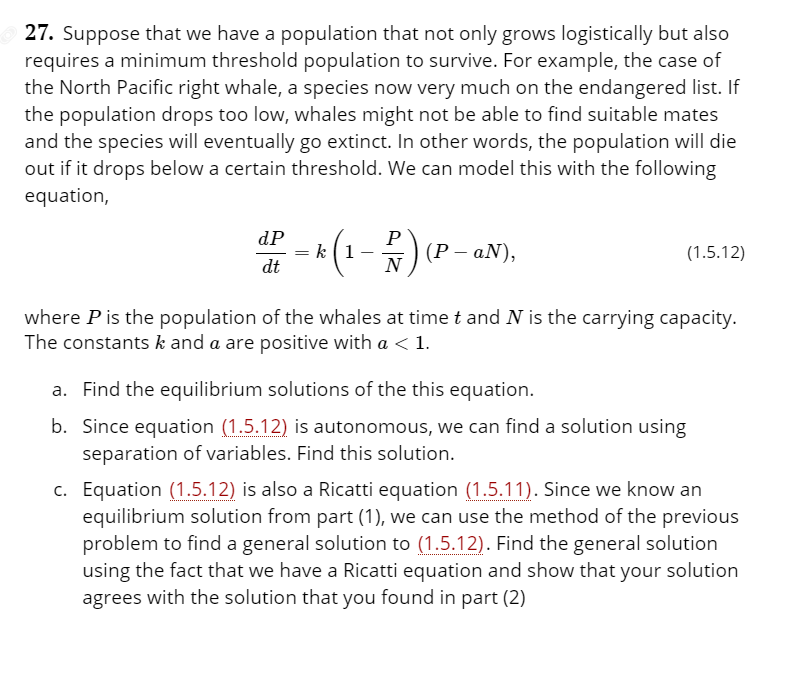27. Suppose that we have a population that not only grows logistically but also requires a minimum threshold population to survive. For example, the case of the North Pacific right whale, a species now very much on the endangered list. If the population drops too low, whales might not be able to find suitable mates and the species will eventually go extinct. In other words, the population will die out if it drops below a certain threshold. We can model this with the following equation, dP P k ( 1 N) (P – aN), (1.5.12) dt where P is the population of the whales at time t and N is the carrying capacity. The constants k and a are positive with a < 1. a. Find the equilibrium solutions of the this equation. b. Since equation (1.5.12) is autonomous, we can find a solution using separation of variables. Find this solution. c. Equation (1.5.12) is also a Ricatti equation (1.5.11). Since we know an equilibrium solution from part (1), we can use the method of the previous problem to find a general solution to (1.5.12). Find the general solution using the fact that we have a Ricatti equation and show that your solution agrees with the solution that you found in part (2)
27. Suppose that we have a population that not only grows logistically but also requires a minimum threshold population to survive. For example, the case of the North Pacific right whale, a species now very much on the endangered list. If the population drops too low, whales might not be able to find suitable mates and the species will eventually go extinct. In other words, the population will die out if it drops below a certain threshold. We can model this with the following equation, dP P k ( 1 N) (P – aN), (1.5.12) dt where P is the population of the whales at time t and N is the carrying capacity. The constants k and a are positive with a < 1. a. Find the equilibrium solutions of the this equation. b. Since equation (1.5.12) is autonomous, we can find a solution using separation of variables. Find this solution. c. Equation (1.5.12) is also a Ricatti equation (1.5.11). Since we know an equilibrium solution from part (1), we can use the method of the previous problem to find a general solution to (1.5.12). Find the general solution using the fact that we have a Ricatti equation and show that your solution agrees with the solution that you found in part (2)
Linear Algebra: A Modern Introduction
4th Edition
ISBN:9781285463247
Author:David Poole
Publisher:David Poole
Chapter2: Systems Of Linear Equations
Section2.4: Applications
Problem 27EQ
Related questions
Topic Video
Question

Transcribed Image Text:27. Suppose that we have a population that not only grows logistically but also
requires a minimum threshold population to survive. For example, the case of
the North Pacific right whale, a species now very much on the endangered list. If
the population drops too low, whales might not be able to find suitable mates
and the species will eventually go extinct. In other words, the population will die
out if it drops below a certain threshold. We can model this with the following
equation,
dP
= k
dt
(1-) (P- aN).
(P – aN),
(1.5.12)
%3D
where P is the population of the whales at time t and N is the carrying capacity.
The constants k and a are positive with a < 1.
a. Find the equilibrium solutions of the this equation.
b. Since equation (1.5.12) is autonomous, we can find a solution using
separation of variables. Find this solution.
c. Equation (1.5.12) is also a Ricatti equation (1.5.11). Since we know an
equilibrium solution from part (1), we can use the method of the previous
problem to find a general solution to (1.5.12). Find the general solution
using the fact that we have a Ricatti equation and show that your solution
agrees with the solution that you found in part (2)
Expert Solution
This question has been solved!
Explore an expertly crafted, step-by-step solution for a thorough understanding of key concepts.
This is a popular solution!
Trending now
This is a popular solution!
Step by step
Solved in 3 steps

Knowledge Booster
Learn more about
Need a deep-dive on the concept behind this application? Look no further. Learn more about this topic, advanced-math and related others by exploring similar questions and additional content below.Recommended textbooks for you

Linear Algebra: A Modern Introduction
Algebra
ISBN:
9781285463247
Author:
David Poole
Publisher:
Cengage Learning

College Algebra (MindTap Course List)
Algebra
ISBN:
9781305652231
Author:
R. David Gustafson, Jeff Hughes
Publisher:
Cengage Learning

College Algebra
Algebra
ISBN:
9781305115545
Author:
James Stewart, Lothar Redlin, Saleem Watson
Publisher:
Cengage Learning

Linear Algebra: A Modern Introduction
Algebra
ISBN:
9781285463247
Author:
David Poole
Publisher:
Cengage Learning

College Algebra (MindTap Course List)
Algebra
ISBN:
9781305652231
Author:
R. David Gustafson, Jeff Hughes
Publisher:
Cengage Learning

College Algebra
Algebra
ISBN:
9781305115545
Author:
James Stewart, Lothar Redlin, Saleem Watson
Publisher:
Cengage Learning